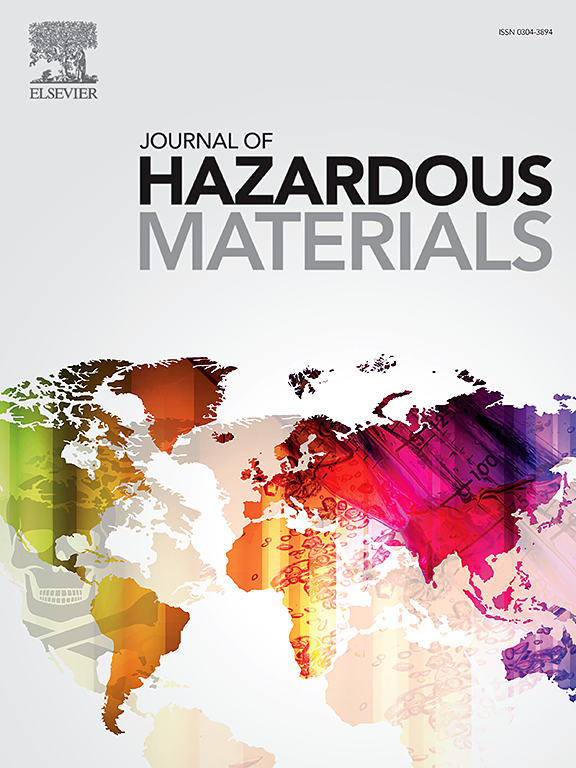COF nanotubes/2D nanosheets heterojunction for superior photocatalytic bactericidal activity even at low concentration and weak light
IF 12.2
1区 环境科学与生态学
Q1 ENGINEERING, ENVIRONMENTAL
引用次数: 0
Abstract
Microbial fouling is a huge nuisance to equipment operation and human health. Two-dimensional (2D) photocatalytic materials such as g-C3N4, WSe2, and Ti3C2Tx, show immense potential for solar-driven eradication of microbial fouling. However, limited photon absorption and rapid photogenerated electron-hole recombination curtail their photocatalytic efficiency and availability, resulting in the necessity to operate at high concentration and strong light. Herein, three kinds of covalent organic frameworks (COF) nanotubes/2D nanosheets heterojunctions (COF-x) were flexibly constructed by in-situ growing COF nanotubes on g-C3N4, WSe2, and Ti3C2Tx nanosheet substrates via one-pot method. The internal electric field at the COF-x coupling interface enhanced the separation and migration of photogenerated charge pairs, contributing to the antimicrobial reactive oxygen species (ROS) produced by COF-x, which was 2.8–270 times more efficient than those of nanosheets. The bactericidal effect enhanced from 34.13 %∼41.68 % of pure nanosheets to over 99.86 % of COF-x at an ultra-low concentration of 2 µg/mL and a weak visible light of 15 mW/cm2. At a low concentration of 20 µg/mL, the bactericidal rate of COF-x achieved nearly 100 % within 6 h. COF-x also showed exceptional environmental stability and antimicrobial properties under heat, light, acid, alkali, and aqueous conditions, offering a new perspective in photocatalytic antimicrobial/antifouling.

COF纳米管/2D纳米片异质结在低浓度弱光下也具有优异的光催化杀菌活性
微生物污染对设备运行和人体健康造成了巨大的危害。二维光催化材料,如g-C3N4、WSe2和Ti3C2Tx,在太阳能驱动的微生物污染根除方面显示出巨大的潜力。然而,有限的光子吸收和快速的光生电子-空穴复合限制了它们的光催化效率和可用性,导致必须在高浓度和强光下工作。本文采用一锅法在g-C3N4、WSe2和Ti3C2Tx纳米片衬底上原位生长COF纳米管,灵活构建了三种共价有机框架(COF)纳米管/2D纳米片异质结(COF-x)。COF-x耦合界面处的内部电场增强了光生电荷对的分离和迁移,使得COF-x产生的抗菌活性氧(ROS)效率是纳米片的2.8~270倍。在2 μ g/mL的超低浓度和15 mW/cm2的弱可见光下,COF-x的杀菌效果从纯纳米片的34.13%~41.68%提高到99.86%以上。在20µg/mL的低浓度条件下,COF-x的杀菌率在6 h内达到近100%。COF-x在热、光、酸、碱和水条件下也表现出优异的环境稳定性和抗菌性能,为光催化抗菌/防污提供了新的视角。
本文章由计算机程序翻译,如有差异,请以英文原文为准。
求助全文
约1分钟内获得全文
求助全文
来源期刊

Journal of Hazardous Materials
工程技术-工程:环境
CiteScore
25.40
自引率
5.90%
发文量
3059
审稿时长
58 days
期刊介绍:
The Journal of Hazardous Materials serves as a global platform for promoting cutting-edge research in the field of Environmental Science and Engineering. Our publication features a wide range of articles, including full-length research papers, review articles, and perspectives, with the aim of enhancing our understanding of the dangers and risks associated with various materials concerning public health and the environment. It is important to note that the term "environmental contaminants" refers specifically to substances that pose hazardous effects through contamination, while excluding those that do not have such impacts on the environment or human health. Moreover, we emphasize the distinction between wastes and hazardous materials in order to provide further clarity on the scope of the journal. We have a keen interest in exploring specific compounds and microbial agents that have adverse effects on the environment.
 求助内容:
求助内容: 应助结果提醒方式:
应助结果提醒方式:


